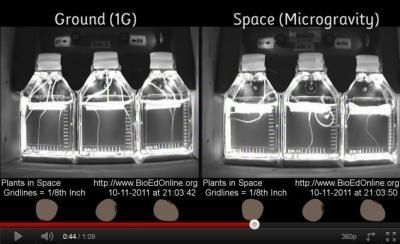Sat, Oct 29, 2011
How Does Your Garden Grow ... In Microgravity?
A unique science project designed to sow the excitement of
scientific discovery in students is sprouting this week aboard the
International Space Station. The Plants in Space project will allow
students and teachers to examine root growth in microgravity and
compare the results with those from plants used in their own
ground-based experiments.
NSRBI YouTube Frame Capture

The National Space Biomedical Research Institute (NSBRI) is
funding the project. It began Tuesday, Sept. 20, when space station
astronauts planted Brassica rapa seeds during the first of four
scheduled five-day trials. The project's primary scientific goal is
to investigate the influence of light on root orientation. "More
than 31 million students have participated in educational
demonstrations on the space station, and more than a million
students have done experiments linked to the space station," said
NASA's International Space Station Program Scientist Julie
Robinson. "It's a powerful force motivating young people to pursue
careers that look to the future."
During the trials, astronauts plant seeds in a clear
nutrient-filled gelatin. They will take daily photographs of root
growth during each trial. Students will design and conduct their
own experiments with the help of a teacher's guide developed by the
NSBRI. Students will be able to compare observations and results of
their investigations to the station experiments and the project's
ground-based control. "An important aspect of the Plants in Space
project is that it is not cookbook science" said Nancy P. Moreno,
NSBRI education and outreach program principal investigator,
professor of allied health sciences at Baylor College of Medicine
(BCM) and senior associate director of its Center for Educational
Outreach. "Unfortunately, too often in science class, kids follow a
procedure, get a predetermined result and really don't experience
the excitement of science and the whole process of discovery. We
know that if we enable students to ask their own questions, design
their own experiments and discover their own answers, they are more
likely to develop a greater interest in science."
The Plants in Space project seeks to determine if white light,
heavy in the blue spectrum, can influence the direction of root
growth in microgravity. Previous research has shown that plant
roots respond weakly to blue light. The project also will study the
effects, if any, of seed orientation on the direction of root
growth. The experiment design calls for mounting seeds in different
orientations on a piece of balsawood, then placing them on top of
the growth medium.
Data gained from the primary and secondary scientific
investigations may help develop systems and techniques so future
astronauts can grow their own food during extended spaceflights to
destinations such as Mars.
More News
“We are disappointed with today’s verdict and respectfully disagree with the outcome. From the outset, we have maintained that Gogo’s independently developed 5G t>[...]
Takeoff Hold Lights (THL) The THL system is composed of in-pavement lighting in a double, longitudinal row of lights aligned either side of the runway centerline. The lights are fo>[...]
Aero Linx: The 1-26 Association (Schweizer) The Association’s goal is to foster the helpfulness, the camaraderie, and the opportunity for head-to-head competition that is fou>[...]
Also: Elfin 20 Journey, BASE Jumper Rescue, Pipistrel Makes Waves, EAA Hall of Fame, Affordable Flying Expo 2026 Like most of the industry, kit manufacturer Sonex has been hit by t>[...]
Aero Linx: The de Havilland Moth Club Ltd The de Havilland Moth Club evolved from a belief that an association of owners and operators of Moth aeroplanes should be formed to create>[...]
 Aero-News: Quote of the Day (11.26.25)
Aero-News: Quote of the Day (11.26.25) ANN's Daily Aero-Term (11.26.25): Takeoff Hold Lights (THL)
ANN's Daily Aero-Term (11.26.25): Takeoff Hold Lights (THL) ANN's Daily Aero-Linx (11.26.25)
ANN's Daily Aero-Linx (11.26.25) Airborne Affordable Flyers 11.20.25: Sonex $$$, SnF 26 MOSAIC DAY, P. Ponk STCs
Airborne Affordable Flyers 11.20.25: Sonex $$$, SnF 26 MOSAIC DAY, P. Ponk STCs ANN's Daily Aero-Linx (11.27.25)
ANN's Daily Aero-Linx (11.27.25)



